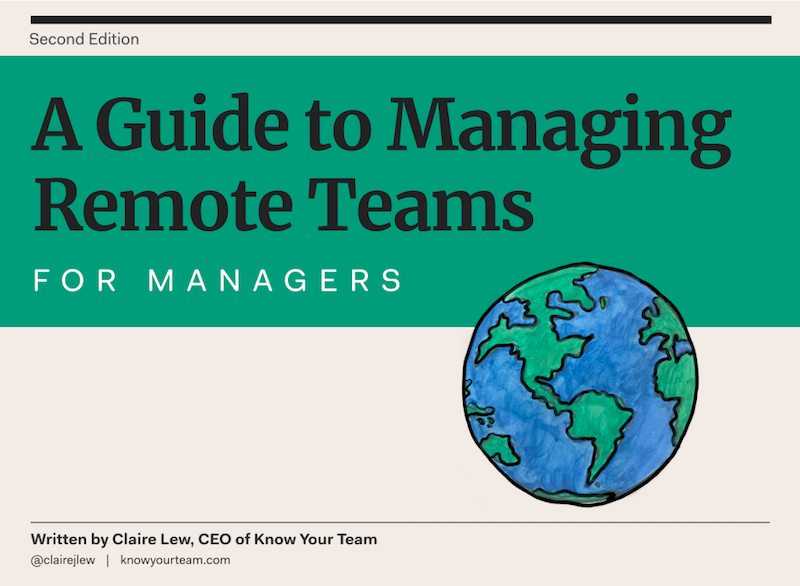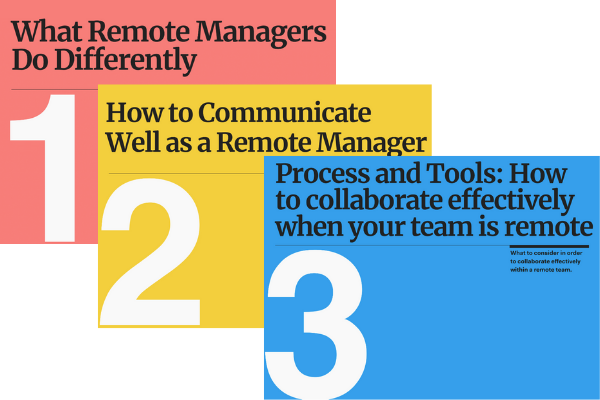If you’re a first-time manager of a remote team, or a manager who’s transitioning to work from home, Know Your Team has released a valuable free 60+ page guide to support you during this time, with knowledge underpinned by their recent research.

Few practical resources exist on how to exactly manage a remote team well. Last year, Know Your Team surveyed 297 remote managers and employees, cited conversations from 1,000+ managers in their leadership community and distilled research on remote work from the past 10 years.
CEO Claire Lew shares 11 chapters on best practices for managing remote teams, based on this research, which cover topics such as communication, tools and processes, social connection, performance management, management and transitions.
Check out the guide or read on to discover some of the key takeaways for managing remote teams.

Use great communication
Working remotely means managers need to do things differently. The biggest difference between managing a remote team versus an in-person team is what you could have guessed: Communication.
“When it comes to communication, there’s one form that is more popular than others in remote teams: Writing. Specifically, “writing synchronously (e.g., chatting via Slack, Basecamp, etc.)” was cited as the primary form of communication in remote teams (45% of survey respondents said this).”
Successful remote managers are diligent about clear, precise writing and communicating with their team on a daily basis. They trust their people and are not afraid to have hard conversations early.
Establish strong processes and use the right tools
With all communication moving online, things can quickly become overwhelming, which is why it’s important to establish strong processes to keep work clean and structured.
“The deluge of communication in a remote team – especially written – may feel like a firehouse. You have an infinite number of Slack messages. Your email inbox seems to pinging with “New unread message” every minute. How do you possibly sift through it all? The answer lies in the process. You have to find a structure, a system, for how all communications are handled. Or else, it will be indeed too much.”
Choose your primary communication tools (emails, online noticeboards, chat, video) and channels thoughtfully. Match your message to the channel.
“What you say can be delivered in a myriad of formats: Email, chat, video call, phone call… So to avoid the barrage of messages pelting others without any rhyme or reason, you’ll want to create some sort of delineation of what kind of message should be delivered in which channel.
“Oftentimes, this is related to the salience and urgency of a message. For instance, a direct message in Slack might insinuate that a message is urgent and should be responded to within the hour, versus something posting a message in a general channel might mean it doesn’t need to be looked at until the next day, if at all.”
Emphasise empathy in the absence of in-person cues
Remote managers report it one of the biggest challenges is communicating with in-person social cues. Requests can seem insensitive without being able to hear someone’s tone, or invasive if you can’t read their expression as they ask.
Remote managers create as many opportunities to create social cues as possible. Video chat is the best solution for solving this challenge.
Using video chat is the closest thing possible to recreate in-person social cues. So use it for one-on-one, team meetings, discussions and brainstorming session.
Be intentional about fostering social connection
Remote leaders are intentional about creating opportunities for social connection.
What are some outside-the-box strategies you can use? Know Your Team recommends ditching dull icebreakers for more dynamic ones, emphasising onboarding and creating a buddy system.
Managers can also establish regular video chats and designate a non-work chat channel.
Set your team members up for success
Let your people understand that there will be a learning curve and that there will be specific new habits and practices that they’ll need to pick up. It takes time, and you’ll all be learning together. Share information about potential pitfalls for them to avoid. For example, it can be easy for people to overwork, become lonely, be interrupted or suffer from miscommunication.
Focus on building trust and rapport, set clear expectations and continue to schedule regular one-on-one meetings.
Not everyone in your team will like working remotely, so be willing to make appropriate adjustments and give as much support as possible. To work effectively, remote managers need to think and work differently. Establishing great communication practices and building trust and social connection will help you achieve success.
Source
A Guide to Managing Remote Teams
Know Your Team

